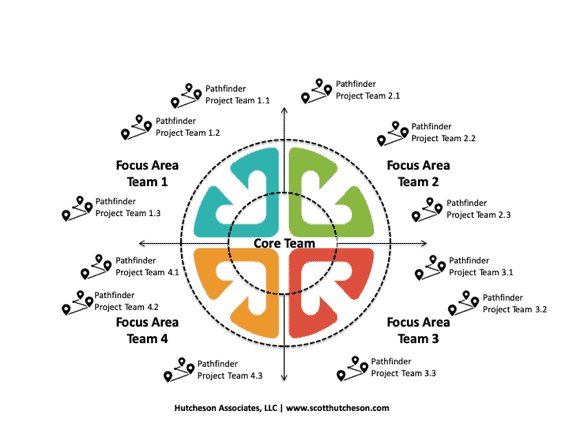Discover, Design, Do – Repeat as Needed: Our Approach to Strategy Development & Execution

Hutcheson Associates (HA) has deep expertise in helping organizations and communities in the development of strategic plans, in building local capacity to guide the ongoing implementation of the plan – adapting the plan as needed. Our approach includes three phases: (1) Strategic Discovery, (2) Strategic Roadmap Design, and (3) Strategic Doing.
Strategic Discovery. The focus of this initial phase is to discover what is truly unique about the organization or community – what’s unique about its challenges and what’s unique about the potential opportunities that lie ahead. To do this, HA gathers and analyzes both quantitative and qualitative data. For a community, quantitative data typically comes from available data sources (federal, state, local). For organizations, this might be a combination of data from publicly available sources and data provided by the organization. Qualitative data is typically collected through interviews and surveys with key internal and external stakeholders. From this data, HA develops a snapshot of the current and desired state related to agreed-upon aspects of the community or organization. This phase also serves to begin considering the means of governance and organizational structure that could best support the community or organization in the future.
Strategic Roadmap Design. The focus of this phase is to begin answering the two basic questions of strategy: (1) where are we going and (2) how will we get there. To accomplish this, HA facilitates the formation of a core team and 3-5 focus area teams. Each of these teams will include 5-7 key stakeholders (internal and external.) The core team provides the overall guidance of the strategic planning effort and the focus area teams work together to create an initial strategic roadmap that defines a desired future state for the community or organization and the pathway for reaching that destination. The core team also tackles the issues of governance and organizational structure.
Strategic Doing. The “roadmap” metaphor is not as powerful as it once was because we now have more dynamic ways to navigate. As drivers, we rely on applications like Google Maps or Waze to chart our path but also give us real-time updates so we can avoid delays and trouble spots. Similarly, we now have tools and frameworks that allow for that same real-time data for our strategic planning efforts. Strategic Doing is one such tool. In this phase, HA uses the Strategic Doing process with each of the focus area teams to begin moving forward on a “pathfinder project” that each group will define and execute and with the core team on issues of governance and organizational structure. These pathfinder projects can be thought of as the first concrete steps in the execution of the strategic roadmap. Also, as part of this phase, the community or organization may select eight individuals to participate in a Strategic Doing Masterclass Practitioner Training. These eight newly trained Strategic Doing Practitioners will then have the skills and knowledge needed to continue the progress of each of the focus area teams as well as the core team’s work on governance and organizational structure. HA works hand-in-hand with the new practitioners to assure they are fully competent to support the strategy execution.
Timeline. This proposed approach usually takes place over approximately ten months. This timeline can be shortened, expanded, and customized for each engagement.

Deliverables & Documentation. The following deliverables are based on a scenario in which there is a core team and four focus area teams, each with seven individuals for a total of 35 people actively engaged in the strategy effort.
- An inventory of the “assets” available to the community or organization that will be especially valuable in the future state envisioned.
- Fifteen strategic opportunities that emerge when assets are linked, leverages, and aligned in new ways.
- Five priority strategic outcome, each with three measurable characteristics of success
- Five pathfinder projects with guideposts that enables the community or organization to get started and test their assumptions. The projects identified will be something that can be accomplished in a short amount of time, usually within 90-120 days.
- A shared strategic action plan with each of the 35 key stakeholders committed to taking on a strategic task.
- Ongoing stakeholder commitment (dates, times, locations) to come back together for learning loops (every 2-4 weeks) to evaluate progress, adjust if needed, and commit to next steps.
Although an initial strategic planning document will be delivered, HA considers plans as living documents that get updated, often monthly, like software. We even number them like software with the first version as 1.0, the second as 1.1, etc.

If you would like to learn more about our approach, please connect with us here.